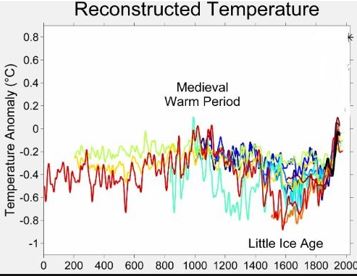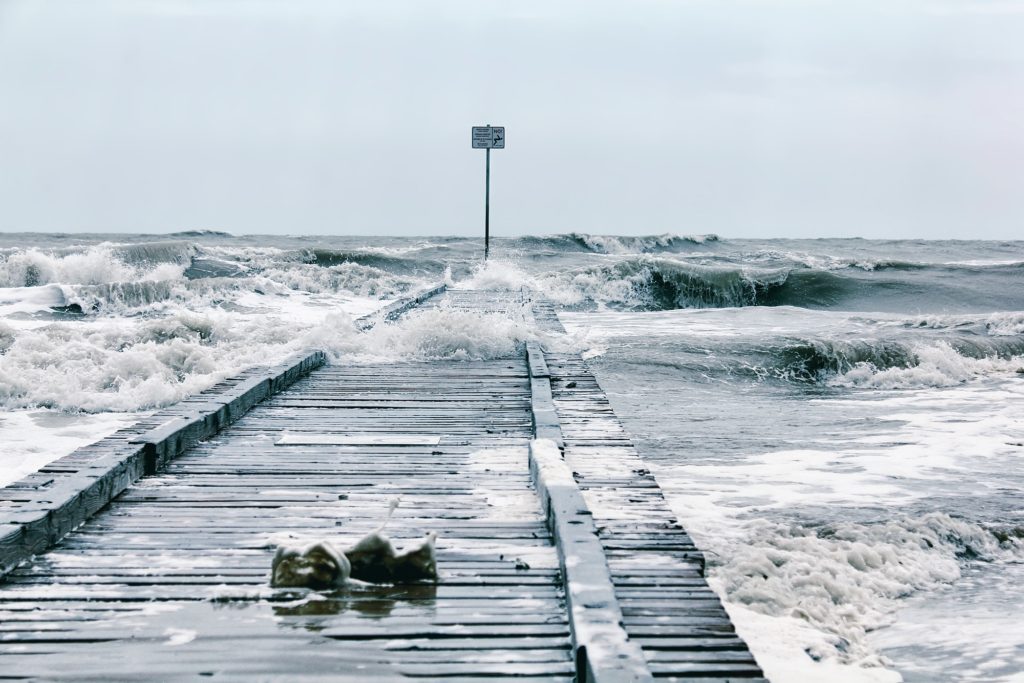Life in the American colonies was quite extremely difficult in the early 18th Century but the winters made it even more so. The winter season of 1716-1717 was particularly harsh. The cold and snow began in November and continued through late March. Beginning in late February, a series of four winter storms (most likely nor’easters) buried areas from Virginia to New England in several feet of snow with incredible drifts. These events became known as “The Great Snow” in various publications. The detrimental impacts of this historic event lasted through March and into early April.
Background
The 1700s are included in a period of time that became known as “The Little Ice Age” which followed a few centuries known as “The Medieval Warm Period”. The “Little Ice Age” generally stretched from the 1500s to the 1800s. There were some warmer interludes during this time but the early 1700s were particularly cold in North America.
The graph is a recreation of global temperature anomalies over many centuries. Note that the early 1700s was in the period known as “The Little Ice Age”. Graph Credit-NASA.
To make matters worse, there were a series of intense volcanic eruptions around the world, most notably in Japan, Indonesia, and the Philippines. The materials that were spewed into the atmosphere cut down the amount of solar radiation that could get through. The result was extremely cold temperatures during the following winters.
There isn’t a whole lot of information back to that time so I will have to rely mainly on what was written for New England. There are other mentions of the snow from Virginia and Pennsylvania to New York. The intense cold and snow began in November and there was an unusual amount of snowfall in November and December.
According to some journals, there were nearly 60 inches of snow on the ground in parts of Massachusetts by the end of 1716. More snow fell in January and some snowdrifts were up to an incredible 25 feet!
“The Great Snow”
On February 27th, 1717, a nor’easter struck New England. This storm produced substantial amounts of snow in interior New England and a combination of snow, sleet, and rain along the coast, with howling wind.
Three more storms, probably nor’easters, spread snow up the East Coast over the next week. The second storm hit on March 1st and that one produced snow all the way to the coast. It was a more severe storm than the first one by all accounts.
On March 4th, there was another storm that was less severe than the second one. The final storm struck New England on March 7th and that produced the most snow of them all, along with a bitterly cold wind and incredible drifts.
All in all, the storms produced around 40 inches of snow around Boston, and towns to the north received over seventy inches. Much of northern Massachusetts had a snow depth of eight to sixteen feet after the final storm. Roads across New England and New York were totally buried in snow. According to one account, the road between Boston and Portsmouth, New Hampshire was somewhere under snowdrifts that were fourteen feet high.
Cotton Mather was a well-known minister and author in his day. The storminess was so bad that he and other writers made note of how incredibly harsh it was throughout New Hampshire, Massachusetts, and Connecticut.
Mather wrote the following about “The Great Snow” which appears in “The history and antiquities of New England, New York, New Jersey, and Pennsylvania” by John Warner Barber. (I left the phrasing and spelling alone).
“ There came on a Snow, which being added unto what had covered the ground a few days before, made a thicker mantle for our Mother than what was usual: And ye storm with it was, for the following day, so violent as to make all communication between ye Neighbors everywhere to cease. People, for some hours, could not pass from one side of a street unto another, & ye poor Women, who happened in this critical time to fall into Travail, were putt unto Hardships, which anon produced many odd stories for us . . . Another Snow came on which almost buried ye Memory of ye former, with a Storm so famous that Heaven laid an Interdict on ye Religious Assemblies throughout ye Country, on this Lord’s day, ye like whereunto had never been seen before.”
A lithograph of Cotton Mather who was a famous minister and author in the 18th century. Image Credit-Wikipedia Commons-Public Domain
Impacts From “The Great Snow”
During that time period in the American colonies, agriculture was the primary means of making a living. During that winter, apple orchards were wiped out as snow buried the trees.
The storms drove wolves, foxes, bears, and wildcats toward the resident’s homes. The wild animals then raided sheep and pig pens. It was estimated that New England lost over 90 percent of the deer population, and many were killed by predators.
Hundreds of cattle perished that winter. When spring came, some were found in a standing position after freezing to death. The number of sheep lost was also catastrophic, many were found dead but huddled together.
Cotton Mather described it in this way :
“Vast numbers of Cattel were destroyed in this Calamity. Whereof some there were, of ye Stranger sort, were found standing dead on their legs, as if they had been alive many weeks after, when ye Snow melted away. And others had their eyes glazed over with Ice at such a rate, that being not far from ye Sea, their mistake of their way drowned them there . . . One gentleman, on whose farms were now lost above 1100 sheep, which with other Cattel, were interred in the Snow, writes me word that there were two Sheep very singularly circumstanced. For no less than eight and twenty days after the Storm, the People pulling out the Ruins 100 sheep out of a Snow Bank, which lay 16 foot high, drifted over them, there was two found alive, which had been there all this time, and kept themselves alive by eating the wool of their dead companions . . . The Poultry as unaccountably survived as these. Hens were found alive after seven days ; Turkeys were found alive after five and twenty days, buried in ye Snow, and at a distance from ye ground, and altogether destitute of anything to feed them. The number of creatures that kept a Rigid Fast, shut up in Snow for diverse weeks together, and were found alive after all, have yielded surprising stories unto us.”
By one account, two pigs actually worked their way out of a snowbank 27 days after the storms ended. They survived by eating tansy (a plant related to the aster). Hens lasted as long as a week under the snow, turkeys as long as 20 days.
After the storms, search parties went out in an attempt to find neighbors, but in many cases, they couldn’t even locate their houses. At times, a bit of smoke that came from a chimney through a hole in the snow was all that was seen.
The snow made it through cracks and openings in barns and accumulated to great heights. Many people couldn’t get to their woodsheds so they started to burn furniture, for warmth, in their fireplaces.
It was impossible to travel on roads to reach markets so many farmers sent out boys with sleds to being back staples like butter and eggs.
The snow delayed mail delivery but boys were summoned to deliver the mail. The boys had to continue this task until the end of March.
Another impact of interest was written about by Cotton Mather and this was an observation from the Atlantic Coast.
“The Ocean was in a prodigious Ferment, and after it was over, vast heaps of little shells were driven ashore, where they were never seen before. Mighty shoals of Porpoises also kept a play-day in the disturbed waves of our Harbours.”
It wasn’t until early April that most of the snow had melted and regular daily activities were resumed.
On a lighter note, Joshua Coffin in his annals titled “History of Newbury, Mass” tells this story :
A man named Abraham Adams escaped through a window in his house and walked three miles on snowshoes to visit his wife who he hadn’t seen since December of 1716. They had just been married a few months earlier. His wife, Abigail, was stuck at her parent’s house through much of the winter. Abraham entered the house through a second-story window.
Apparently, the couple was more than happy to see each other and they welcomed the birth of their first child nine months later. They named the boy Robert by the way.
In the next century, the famous poet and journalist Henry David Thoreau made reference to “The Great Snow”: “The Indians nearly a hundred years old affirm that their fathers never told them of anything that equaled.”
Epilogue
Due to the sketchy information, I chose not to recreate a synoptic weather pattern that was responsible for this incredible series of events. Imagine a group of meteorologists in the Northeast U.S. watching computer models come in and there are four winter storms projected to occur within eight days …. and all of them verified!




